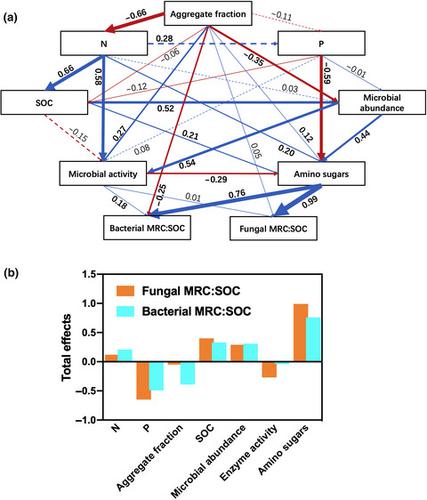当前位置:
X-MOL 学术
›
Glob. Change Biol.
›
论文详情
Our official English website, www.x-mol.net, welcomes your feedback! (Note: you will need to create a separate account there.)
Phosphorus addition decreases microbial residual contribution to soil organic carbon pool in a tropical coastal forest
Global Change Biology ( IF 11.6 ) Pub Date : 2020-10-17 , DOI: 10.1111/gcb.15407 Ye Yuan 1, 2 , Yue Li 1, 3 , Zhijian Mou 1, 2 , Luhui Kuang 1, 2 , Wenjia Wu 1, 3, 4 , Jing Zhang 1, 3, 4 , Faming Wang 1, 3, 4, 5 , Dafeng Hui 6 , Josep Peñuelas 7, 8 , Jordi Sardans 7, 8 , Hans Lambers 9, 10 , Jun Wang 1, 3, 4 , Yuanwen Kuang 1, 3, 4 , Zhi’an Li 1, 3, 4 , Zhanfeng Liu 1, 3, 4
Global Change Biology ( IF 11.6 ) Pub Date : 2020-10-17 , DOI: 10.1111/gcb.15407 Ye Yuan 1, 2 , Yue Li 1, 3 , Zhijian Mou 1, 2 , Luhui Kuang 1, 2 , Wenjia Wu 1, 3, 4 , Jing Zhang 1, 3, 4 , Faming Wang 1, 3, 4, 5 , Dafeng Hui 6 , Josep Peñuelas 7, 8 , Jordi Sardans 7, 8 , Hans Lambers 9, 10 , Jun Wang 1, 3, 4 , Yuanwen Kuang 1, 3, 4 , Zhi’an Li 1, 3, 4 , Zhanfeng Liu 1, 3, 4
Affiliation

|
The soil nitrogen (N) and phosphorus (P) availability often constrains soil carbon (C) pool, and elevated N deposition could further intensify soil P limitation, which may affect soil C cycling in these N‐rich and P‐poor ecosystems. Soil microbial residues may not only affect soil organic carbon (SOC) pool but also impact SOC stability through soil aggregation. However, how soil nutrient availability and aggregate fractions affect microbial residues and the microbial residue contribution to SOC is still not well understood. We took advantage of a 10‐year field fertilization experiment to investigate the effects of nutrient additions, soil aggregate fractions, and their interactions on the concentrations of soil microbial residues and their contribution to SOC accumulation in a tropical coastal forest. We found that continuous P addition greatly decreased the concentrations of microbial residues and their contribution to SOC, whereas N addition had no significant effect. The P‐stimulated decreases in microbial residues and their contribution to SOC were presumably due to enhanced recycling of microbial residues via increased activity of residue‐decomposing enzymes. The interactive effects between soil aggregate fraction and nutrient addition were not significant, suggesting a weak role of physical protection by soil aggregates in mediating microbial responses to altered soil nutrient availability. Our data suggest that the mechanisms driving microbial residue responses to increased N and P availability might be different, and the P‐induced decrease in the contribution of microbial residues might be unfavorable for the stability of SOC in N‐rich and P‐poor tropical forests. Such information is critical for understanding the role of tropical forests in the global carbon cycle.
中文翻译:

磷的添加减少了热带沿海森林中微生物残留对土壤有机碳库的贡献
土壤氮(N)和磷(P)的可利用性通常会限制土壤碳(C)的积累,氮的增加沉积会进一步加剧土壤P的限制,这可能会影响这些富含N和P少的生态系统中土壤C的循环。土壤微生物残留不仅可能影响土壤有机碳(SOC),而且还会通过土壤聚集而影响SOC的稳定性。然而,土壤养分的有效性和聚集体组分如何影响微生物残留以及微生物残留对SOC的贡献仍知之甚少。我们利用一项为期10年的田间施肥实验,研究了养分添加,土壤团聚体组分及其相互作用对热带沿海森林土壤微生物残留浓度及其对SOC积累的贡献的影响。我们发现,连续添加P会大大降低微生物残留物的浓度及其对SOC的贡献,而添加N则没有显着影响。P刺激的微生物残基减少及其对SOC的贡献大概是由于通过残基分解酶活性的增加而增强了微生物残基的再循环。土壤团聚体组分与养分添加之间的相互作用影响不显着,表明土壤团聚体在介导微生物对土壤养分利用率变化的响应中,物理保护作用微弱。我们的数据表明,驱动微生物残留物响应增加的氮和磷有效性的机制可能有所不同,P引起的微生物残留贡献的降低可能不利于N丰富和P贫乏的热带森林中SOC的稳定性。这些信息对于理解热带森林在全球碳循环中的作用至关重要。
更新日期:2020-12-15
中文翻译:

磷的添加减少了热带沿海森林中微生物残留对土壤有机碳库的贡献
土壤氮(N)和磷(P)的可利用性通常会限制土壤碳(C)的积累,氮的增加沉积会进一步加剧土壤P的限制,这可能会影响这些富含N和P少的生态系统中土壤C的循环。土壤微生物残留不仅可能影响土壤有机碳(SOC),而且还会通过土壤聚集而影响SOC的稳定性。然而,土壤养分的有效性和聚集体组分如何影响微生物残留以及微生物残留对SOC的贡献仍知之甚少。我们利用一项为期10年的田间施肥实验,研究了养分添加,土壤团聚体组分及其相互作用对热带沿海森林土壤微生物残留浓度及其对SOC积累的贡献的影响。我们发现,连续添加P会大大降低微生物残留物的浓度及其对SOC的贡献,而添加N则没有显着影响。P刺激的微生物残基减少及其对SOC的贡献大概是由于通过残基分解酶活性的增加而增强了微生物残基的再循环。土壤团聚体组分与养分添加之间的相互作用影响不显着,表明土壤团聚体在介导微生物对土壤养分利用率变化的响应中,物理保护作用微弱。我们的数据表明,驱动微生物残留物响应增加的氮和磷有效性的机制可能有所不同,P引起的微生物残留贡献的降低可能不利于N丰富和P贫乏的热带森林中SOC的稳定性。这些信息对于理解热带森林在全球碳循环中的作用至关重要。


























 京公网安备 11010802027423号
京公网安备 11010802027423号